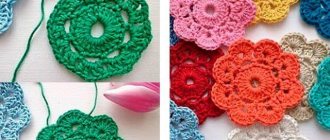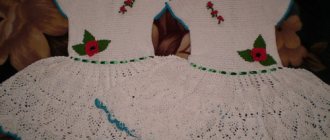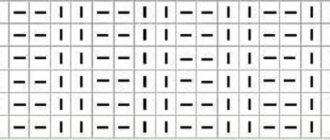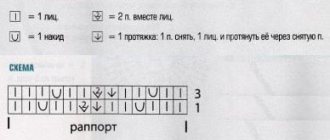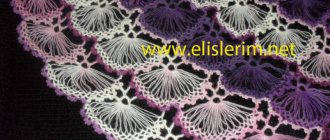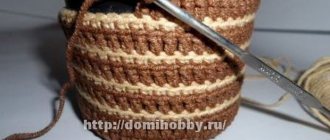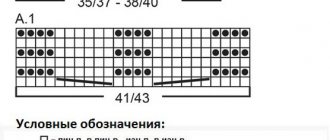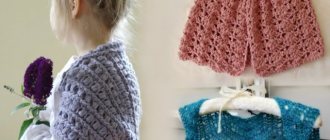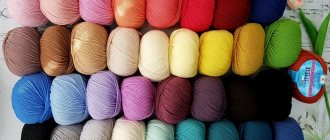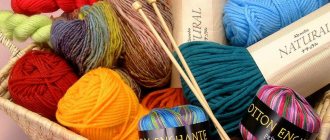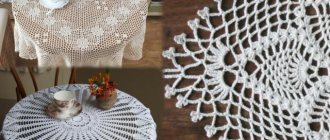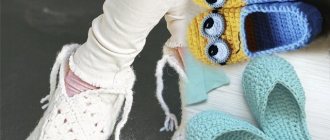A little history and purpose
It is not known for certain when the first devices appeared to help cleanse the skin, but already in references in Babylon and Ancient Greece there is information about the first washcloths. Wealthy people used wood or bronze to wash their skin, while poor people used bunches of plants or sand.
Now, a washcloth is already an absolutely necessary household item for every person. Beautifully designed, of different sizes, colors and purposes, they decorate the bathroom and are indispensable assistants in the bathroom.
A washcloth can be made from any available material: natural cotton or chintz, using old terry towels, woven from burlap, and for those who are not looking for easy ways - knitted.
What kind of yarn is there?
Both natural and artificial materials can be used for knitting washcloths.
Natural washcloths are healthier, but they last much less, since they contain pathogenic organisms and can rot and mold. Their maximum service life is 1 month, after which the washcloth should be replaced with a new one. Washcloths made from synthetic threads last much longer; it is recommended to use them for no more than 3 months, although their strength can be maintained for more than a year:
- Cotton and linen. Cotton washcloths are soft and suitable for children and people with very delicate and sensitive skin or those suffering from skin diseases. Linen washcloths have a beneficial effect on blood circulation.
- Polypropylene. It is considered a fairly strong synthetic material. Washcloths made from such threads lather well and are able to perfectly remove sweat, fat and dead skin cells.
- Leg-split. Polypropylene twine, which is very durable, is more suitable for washcloths. But natural ones are also suitable: jute or linen.
- Sisal. Obtained from the leaves of Agave sisalana. This material is more suitable for flat massage sponges that work well on rough skin.
- Plastic bags. Knitting washcloths from this material is considered a utilitarian craft that is beneficial and helps to get rid of unnecessary things. Washcloths knitted from bags are suitable for people with delicate and sensitive skin. It is not recommended to use them when using scrubs.
- Nylon tights. Fragile women's products quickly break down and have to be replaced frequently. Needlewomen do not throw them away, but use them for knitting washcloths, cutting them into strips 3-4 cm wide. It is better if the washcloths made from tights are flat.
- Sock additive. The material is quite durable, suitable for any washcloths, even those intended for washing dishes.
- Viscose. Washcloths made from artificial fiber, which is made from pine or bamboo wood, are quite durable and beautiful.
- Acrylic. Sponges made of acrylic, a synthetic polymer fiber made from petroleum products, are very durable and reliable.
- Bags. If you don’t have yarn on hand, you can unravel the used bag. Pre-washed sugar and flour bags are suitable. The washcloth will be durable and beautiful.
Ready washcloths 10 min. should be kept in boiling water. They will become more pleasant and lather better.
The technique of knitting washcloths is simple. Women who know how to hold a hook and knitting needles will do it easily. There is also a method of knot weaving, close to macrame. If the size and style are chosen, then the next step is to decide on the material. And then your eyes widen, what kind of yarn does not exist! Take natural fibers:
- Jute is a textile fiber, material for twine and burlap. The strands are hard, good material for washcloths.
- Manila fiber from abaca (spinning banana).
- Hemp is the fiber from the stems of hemp.
- Bast is a deep layer of linden or willow bark, a wonderful material that releases phytoncides beneficial to health, but unfortunately it is short-lived.
- Loofah - “loofah gourd” or “crazy cucumber”, the dried and peeled core itself is a ready-made loofah, but if you are not satisfied with the shape, you can comb out the fiber for spinning.
- Sisal is a coarse agave fiber, a guest from South America.
- Ramie is a Chinese nettle, our Russian one is no worse, you just need to squeeze the stems correctly, dry them and fluff them into fibers. Enthusiasts do the same with rhubarb petioles.
- Cotton yarn is a wonderful material, but not very practical for washcloths.
- Flax, flax fiber is a product of processing flax straw.
- Wool is an excellent yarn for washcloths, the coarser the better.
- Steel is most often found in the form of lace wire scourers or twisted springy strips, and is primarily used for cleaning utensils.
- Exotic materials such as birch bark and stone wool (granite, basalt).
Polypropylene fibers and threads are characterized by increased strength. Accordingly, yarn for washcloths made of polypropylene is a very convenient material for needlework. Absolutely not afraid of moisture and mechanical impact. Has high wear resistance
There are 100% polypropylene yarns on sale, as well as other types of composite yarns where polypropylene makes up part of the fibers. The number of colors and shades is more than 50.
We invite you to familiarize yourself with Wood-effect tiles for the bathhouse
Skeins are produced in various assortments weighing 25, 50, 100 and 200 grams.
The threads are pleasant to the touch, easily lie on the hook and are picked up by knitting needles. Lovers of knot weaving give positive feedback; weaving polypropylene yarn is not difficult.
Kese washcloth
This washcloth is designed to remove dirt from the skin without the use of scrubs and cleansing gels. If a person has sensitive skin, it is made from natural fibers, silk; for coarser skin, it is made from sheep or goat wool.
Its homeland is the East; from ancient times to this day it has been woven in the traditional way - crocheted. First, you need to knit a handle of 40 loops with two threads, on the third, start knitting cap stitches to the end of the chain - the first handle is ready, we make the second in the same way and fasten its end to the first.
The main part of the washcloth consists of three stitches of 16 single crochets, connected to three stitches of 16 double crochets. The washcloth is ready!
It must be thoroughly washed with water and wrung out well to avoid the appearance of various bacteria and unpleasant odors, since the material used in the base does not dry well and retains moisture for a long time.
How to knit a universal washcloth? Master class and description for beginners.
Simple, but so comfortable, this washcloth will scrub your back like no other. A needlewoman with any skill level can easily handle knitting this useful item.
We will need:
- “yarn” made of polypropylene (you can also make it from twine, thick thread - whatever);
- hook number 2.
Step-by-step instructions and work diagram
We collect a braid from 56 centuries. etc., close it in a circle without twisting the loops. Then - 4 rows with. without n., and the 5th row - elongated loops, 6th row - again with. without n. We continue in this way for 14 r.. We cut the thread, straightening its tail to the front side, attach a thread of a different color and alternate 4-5 r. again. The needlewoman can combine several colors, make the washcloth rainbow, or knit one color “solo” until the end.
When we reach the desired length of the product, we knit 3 more rows with. without n..
Pens
Using the same thread, the needlewoman picks up a 65-century braid. p.. Do not be afraid that the handles will be short - the material will stretch a little after several uses, then we secure our braid on the other side. Now - 2 rubles. With. without n.. We do the same on the other side of the shaggy washcloth and the handles are ready.
Video master class
Burlap washcloth
If you don’t know how to knit or don’t want to, you can make a beautiful washcloth with your own hands using burlap, for this you will need: burlap, foam rubber or sponge, gauze, soap and elastic, and also a piece of cotton fabric.
From burlap you need to cut two identical rectangles slightly larger than your palm, and the same ones for the gauze lining. A holder for a bath accessory is made using an elastic band, assembled like an accordion and covered with fabric. One end is secured in the middle of a burlap rectangle, and the other is sewn to the side.
Next, the burlap is sewn together to form a bag and pieces of soap and a sponge are placed in it to create foam; dried lavender or mint can be added for scent. The washcloth needs to be sewn up. It is ready to use. When the soap in it stops foaming, you will need to rip it open and pour in a new portion.
From pumpkin and tights
Today there are quite a lot of materials for creating washcloths with your own hands. Depending on whether you want to have this bath attribute made from natural or artificial threads, not only the price of the finished product depends, but also its appearance. As a rule, yarn from natural or artificial materials is used to weave washcloths. Less commonly, natural materials that only need to be cut into cubes before use. So, a striking example of this is the loofah (loofah, luffa).
This is a herbaceous plant from the pumpkin family, which, when ripe and dried, is a natural loofah - you just need to remove a layer of hard peel. Initially, luffa was widespread in the countries of the African continent and in some regions of Asia, but now it can be grown even in the southern regions of our country. The advantages of a natural luffa washcloth are that it not only perfectly cleanses the skin of dead cells, but also has a massage effect on the body.
But the more common materials for creating homemade bath sponges are:
- nylon;
- polypropylene;
- sheep yarn;
- flax fiber;
- ramie
Nylon can be used to create a washcloth in two versions, both of which do not require large financial outlays. Firstly, you can cut nylon tights into narrow strips. These strips will make excellent yarn, from which it will be possible to knit soft washcloths using a crochet hook or knitting needles. The second option is to find a nylon net, in which, for example, onions are sold. In this case, it will need to be thoroughly washed first and additionally treated with boiling water.
The instructions for making a mesh washcloth are as simple as possible. Pass one knitting needle through separate loops of the net, passing two or three between them. Once you have the entire length of the mesh on your knitting needle, pass a strong rope through these loops and pull both ends of the mesh material together and tie it tightly. As a result, you will get something that looks like a voluminous first-grader’s bow.
An interesting one would be a washcloth knitted from yarn made from Chinese nettle ramie fibers. But you need to choose a thread with a main component content of at least 70% so that it is of medium hardness, ensuring good cleansing of the skin. Ramie is also famous for its anti-inflammatory and rejuvenating effects on the body.
An excellent material for a high-quality washcloth is sheep yarn - but not merino sheep, but breeds with less delicate and soft wool. You can buy this at yarn stores. Their advantage is that even threads with a hundred percent wool content are quite inexpensive (unlike merino, which is highly valued). This yarn is somewhat harsh to the touch, so it is not often used for knitting items of clothing, but it is best suited for a bath washcloth. This material will cleanse the skin even from serious dirt. Products made from linen thread perform similarly well.
Mesh washcloth
A washcloth can also be constructed from a mesh, which can be purchased in any bathroom department of a large hardware supermarket or at a bazaar.
To do this, you need to form a bag out of it, insert pre-cut foam rubber and fix it on top. The sponge will create a thick foam that can cleanse pores and give freshness to the skin.
From plastic bags
A large selection of multi-colored plastic bags, different in texture, is used for knitting washcloths. You can take already used ones, or you can buy new ones. It is better to choose softer ones that do not have handles or ties.
| The bag must be folded several times to one side, leaving approximately 2.5 cm. | |
| The folded part of the package is cut into strips 2.5-3 cm wide, not cutting completely. | |
| The strips are straightened in length. | |
| Then the uncut part is straightened out and the strips are cut diagonally. The cuts go from the cut of the 1st strip to the 2nd, from the cut of the 2nd strip to the 3rd and so on. | |
| It should turn out like this. | |
| The arrow shows the seam of the bag. |
Next, the strips are wound into balls and you can start working. For a washcloth, the size of which is 70*15 cm, approximately 30 medium bags are required. You can knit in any way; you can add elongated loops for strength and looseness.
We invite you to familiarize yourself with Insulation for a steam room on the inside of a bathhouse
Polypropylene washcloth
To knit such a bath “helper”, it is enough to purchase the appropriate threads and a hook size 5-6 with a round head. Initially, you need to knit a chain of loops 20 cm long and connect them into a ring.
Next, you need to knit the main fluffy part of the washcloth using the “DC” method and finish with several rows of “SC”, and at the end knit the handles. This way you can knit a washcloth from any material.
Toys and mittens made of polypropylene thread
These artificial materials, from which various shower sponges are most often knitted, are convenient because they are quite easy to work with. The thread does not fluff for obvious reasons and does not get tangled, so it is easy to handle both with crochet and knitting needles. Another positive factor of polypropylene yarn is the wide range of colors. Using this material it is very convenient to knit multi-colored washcloths or bath accessories in the form of toys. The latter are especially popular with children.
You need to knit from polypropylene with knitting needles and crochet no finer than number four or even number five. This thread is quite stiff, and therefore it is advisable not to pull it very tightly, since a washcloth that is too coarse is not suitable for use. Moreover, you need to be especially scrupulous about this issue if you plan to knit a washcloth for a child. Therefore, do not rush to start working right away, but first knit several test rows with knitting needles or crochets of different sizes to find the most suitable knitting density.
If you decide to knit with polypropylene threads using a hook, then choose a tool model with a rounded head. A sharp end can disrupt the structure of the thread, breaking it.
Polypropylene makes beautiful washcloths in the shape of a hedgehog toy. To do this, you will need threads of two different colors: darker - to create its needles and lighter - for the muzzle. You need to crochet a hedgehog with elongated loops as follows.
- Cast on 20 cm of loops with a dark thread, connect them into a ring and knit two rows with single crochets.
- Make several rows of elongated loops: pull out the loops two to three centimeters long and remove them from the hook, knitting the loops through one stitch.
- Knit with elongated loops 10 centimeters in height.
- Next, use light threads to knit the cone-shaped face of the animal.
- Knit according to this pattern - two single crochets, then skip the next loop and two double crochets again - so that the knitting begins to taper.
- Knit in this way until all the loops come together.
- Make the nose and eyes of the animal from black thread - and the washcloth is ready.
In addition, you can make a knitted washcloth in the shape of a mitten from polypropylene thread, which will be not only beautiful, but also a convenient bath accessory. Two identical parts of the product are knitted. First of all, you need to crochet 20 loops and knit five rows with single crochets. Then, to knit a finger at the end of the row, you should cast on eight air loops and tie them with double crochets. Return to the main fabric and knit five more rows with single crochets, then begin to cut the loops, rounding the top of the mitten. To do this, do not knit one stitch from each edge of the knitting until the mitten is completely rounded. Complete the second part of the product in the same way and sew the finished halves together.
Results
If you look at examples of photos of do-it-yourself washcloths in books, brochures, craft magazines or on the Internet, you will see what a variety of these bath items there are. In addition to the original accessory, spending a minimum of time and effort, you will receive a real decoration for the bathroom, an indispensable cleanser suitable for your skin and save money.
Such washcloths can be given as a gift or an addition to a gift, or they can also be sewn for children in the form of various animals or cartoon characters. The child will be more willing to bathe with such a gift.
Why should you pay attention to this type of needlework?
A product made independently is much cheaper than similar ones on sale. You only pay for materials. You can also choose the color and design of the washcloth yourself. Among the variety of materials, you will find exactly the one that suits you.
This article will discuss techniques for knitting washcloths for beginners and provide step-by-step instructions for knitting a washcloth. You will also learn such an interesting technique as knitting a washcloth in loops.
Synthetic or natural material?
Both synthetic and natural materials can be used to make washcloths. Natural materials are undoubtedly useful, but the service life of such a washcloth is about a month, since microorganisms will develop in it over time. Synthetic materials provide greater durability, the recommended period of use is up to three months.
